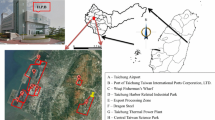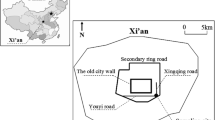Abstract
PM2.5 has become an important environmental issue in Taiwan during the past few years. Moreover, electricity increased significantly during the summertime and TTPP generated by coal burning base is the main electricity provider in central Taiwan. Therefore, summer season has become the main research target in this study. The ambient air concentrations of particulate matter PM2.5 and PM10 collected by using VAPS at a mixed characteristic sampling site were studied in central Taiwan. The results indicated that the average daytime PM2.5 and PM10 particulate concentrations were occurred in May and they were 44.75 and 57.77 µg/m3 in this study. The results also indicated that the average nighttime PM2.5 and PM10 particulate concentrations were occurred in June and they were 38.19 and 45.79 µg/m3 in this study. The average PM2.5/PM10 ratios were 0.7 for daytime, nighttime and 24-h sampling periods in the summer for this study. This value was ranked as the lowest ratios when compared to the other seasons in previous study. Noteworthy, the results further indicated that the metallic element Pb has the mean highest concentrations for 24-h, daytime and nighttime sampling periods when compared to those of the other metallic elements (Ni, Cu, Zn and Cd). The average mean highest metallic Pb concentrations in PM10 were 110.7, 203.0 and 207.2 ng/m3 for 24-h, daytime and nighttime sampling periods in this study. And there were 59.53, 105.2 and 106.6 ng/m3 for Pb in PM2.5 for 24-h, daytime and nighttime sampling periods, respectively. Moreover, the results further indicated that mean metallic element Pb concentrations on PM2.5 and PM10 were all higher than those of the other elements for 24 h, day and nighttime.

Similar content being viewed by others
References
Agency for Toxic Substances and Disease Registry (ATSDR). (2004) Public health statement copper. Department of Health and Human Services, Public Health Service Agency for Toxic Substances and Disease Registry. CAS#: 7440-50-8.
Cabral, M., Toure, A., Garçon, G., Diop, C., Bouhsina, S., Dewaele, D., et al. (2015). Environmental pollution. Environmental Pollution, 206(2015), 247–255.
Chan, C. K., & Yao, X. (2008). Air pollution in mega cities in China. Atmospheric Environment, 42, 1–42.
Chen, P., Bi, X., Zhang, J., Wu, J., & Feng, Y. (2015). Assessment of heavy metal pollution characteristics and human health risk of exposure to ambient PM2.5 in Tianjin, China. Particuology, 20, 104–109.
Cheng, Y., Lee, S. C., Ho, K. F., Chow, J. C., Watson, J. G., Louie, P. K. K., et al. (2010). Chemically-speciated on-road PM2.5 motor vehicle emission factors in Hong Kong. Science of the Total Environment, 408, 1621–1627.
Dominici, F., Peng, R. D., Bell, M. L., Pham, L., McDermott, A., Zeger, S. L., & Samet, J. M. (2006). Fine particulate air pollution and hospital admission for cardiovascular and respiratory diseases. Journal of the American Medical Association, 295, 1127–1134.
Fabretti, J. F., Sauret, N., Gal, J. F., Maria, P. C., & Schärer, U. (2009). Elemental characterization and source identification of PM2.5 using positive matrix factorization: The Malraux road tunnel, Nice, France. Atmospheric Research, 94, 320–329.
Fang, G. C., Chang, C. N., Chu, C. C., Wu, Y. S., Fu, P. P. C., Yang, I. L., & Chen, Ming-Hsiang. (2003). Characterization of particulate, metallic elements of TSP, PM2.5 and PM2.5-10 aerosols at a farm sampling site in Taiwan, Taichung. The Science of the Total Environment, 308, 157–166.
Fang, G. C., Huang, Y. L., Huang, J. H., & Liu, C. K. (2012). Dry deposition of Mn, Zn, Cr, Cu and Pb in particles of sizes of 3 μm, 5.6 μm and 10 μm in central Taiwan. Journal of Hazardous Materials, 203–204(15), 158–168.
Fang, G. C., Wu, Y. S., Fu, P. P. C., Chang, C. N., Chen, M. H., Ho, T. T., et al. (2005). Metallic elements study of fine and coarse particulates using a versatile air pollutant system at a traffic sampling site. Atmospheric Research, 75, 1–14.
Fang, G. C., & Zheng, Y. C. (2014). Diurnal ambient air particles, metallic elements dry deposition, concentrations study during year of 2012–2013 at a traffic site. Atmospheric Environment, 88, 39–46.
Fekiacova, Z., Cornu, S., & Pichat, S. (2015). Tracing contamination sources in soils with Cu and Zn isotopic ratios. Science of the Total Environment, 517, 96–105.
Geng, N., Wang, J., Xu, Y., Zhang, W., Chen, C., & Zhang, R. (2013). PM2.5 in an industrial district of Zhengzhou, China: Chemical composition and source apportionment. Particuology, 11, 99–109.
Han, Y. J., Kim, H. W., Cho, S. H., Kim, P. R., & Kim, W. J. (2015). Metallic elements in PM2.5 in different functional areas of Korea: Concentrations and source identification. Atmospheric Research, 153, 416–428.
Hassanvand, M. S., Naddafi, K., Faridi, S., Nabizadeh, R., Sowlat, M. H., Momeniha, F., et al. (2015). Characterization of PAHs and metals in indoor/outdoor PM10/PM2.5/PM1 in a retirement home and a school dormitory. Science of the Total Environment, 527–528, 100–110.
Ho, K. F., Lee, S. C., Chan, C. K., Yu, J. C., Chow, J. C., & Yao, X. H. (2003). Characterization of chemical species in PM2.5 and PM 10 aerosols in Hong Kong. Atmospheric Environment, 37, 31–39.
Hu, H., Yang, Q., Lu, X., Wang, W. C., Wang, S. S., & Fan, M. H. (2010). Air pollution and control in different areas of China. Critical Reviews in Environmental Science and Technology., 40, 452–518.
International Agency for Research on Cancer. (1990). IARC monographs on the evaluation of carcinogenic risks to humans. Chromium, Nickel and Welding (Vol. 49, pp. 257–445). Lyon: IARC Scientific Publications.
Kasprzak, K. S., Sunderman, F. W, Jr., & Salnikow, K. (2003). Nickel carcinogenesis. Mutation Research Fundamental and Molecular Mechanisms of Mutagenesis, 533(1–2), 67–97.
Kim, K. H., Choi, G. H., Kang, C. H., Lee, J. H., Kim, J. Y., Youn, Y. H., & Lee, S. R. (2003). The chemical composition of fine and coarse particles in relation with the Asian Dust events. Atmospheric Environment, 37, 753–765.
Laakso, L., Hussein, T., Aarnio, P., Komppula, M., Hiltunen, V., Viisanen, Y., & Kulmala, M. (2003). Diurnal and annual characteristics of particle mass and number concentrations in urban, rural and Arctic environments in Finland. Atmospheric Environment, 37, 2629–2641.
Lee, J. C., Son, Y. O., Pratheeshkumar, P., & Shi, X. (2012). Oxidative stress and metal carcinogenesis. Free Radical Biology and Medicine, 53(2012), 742–757.
Lin, C. C., Chen, S. J., Huang, K. L., Hwang, W. I., Chien-Chine, G. P., & Lin, W. Y. (2005). Characteristics of metals in nano/ultrafine/fine/coarse particles collected beside a heavily trafficked road. Environmental Science and Technology, 39(21), 8113–8122.
Liu, X., Zhai, Y., Zhu, Y., Liu, Y., Chen, H., Li, P., et al. (2015). Mass concentration and health risk assessment of heavy metals in size-segregated airborne particulate matter in Changsha. Science of the Total Environment, 517, 215–221.
Mohanraj, R., & Azeez, P. A. (2004). Health effects of airborne particulate matter and the Indian scenario. Current Science India, 87, 741–748.
Mohiuddin, K., Strezov, V., Nelson, P. F., & Stelcer, E. (2014). Characterisation of trace metals in atmospheric particles in the vicinity of iron and steelmaking industries in Australia. Atmospheric Environment, 83, 72–79.
Mooibroek, D., Schaap, M., Weijers, E. P., & Hoogerbru, R. (2011). Source apportionment and spatial variability of PM2.5 using measurements at five sites in the Netherlands. Atmospheric Environment, 45, 4180–4191.
Olson, D. A., Turlington, J., Duvall, R. M., McDow, S. R., Stevens, C. D., & Williams, R. (2008). Indoor and outdoor concentrations of organic and inorganic molecular markers: Source apportionment of PM2.5 using low-volume samples. Atmospheric Environment, 42, 1742–1751.
Ono, K. (2013). Past and future cadmium emissions from municipal solid-waste incinerators in Japan for the assessment of cadmium control policy. Journal of Hazardous Materials, 262, 741–747.
Pope, C. A, I. I. I., Burnett, R. T., Thurston, G. D., Thun, M. J., Calle, E. E., Krewski, D., & Godleski, J. J. (2004). Cardiovascular mortality and long-term exposure to particulate air pollution: epidemiological evidence of general pathophysiological pathways of disease. Circulation, 109, 71–77.
Shaltout, A. A., BernhardWelz, J. B., Castilho, I. N. B., AlAshkar, E. A., & Gaita, S. M. (2014). Method development for the determination of Cd, Cu, Ni and Pb in PM2.5 particles sampled in industrial and urban areas of Greater Cairo, Egypt, using high-resolution continuum source graphite furnace atomic absorption spectrometry. Microchemical Journal, 113, 4–9.
Sun, L. M., Lin, Z. Q., Liao, K., Xi, Z. G., & Wang, D. Y. (2015). Adverse effects of coal combustion related fine particulate matter (PM2.5) on nematode Caenorhabditis elegans. Science of the Total Environment, 512–513, 251–260.
Szigeti, T., Óvári, M., Dunster, C., Kelly, F. J., Lucarelli, F., & Záray, G. (2015). Changes in chemical composition and oxidative potential of urban PM2.5 between 2010 and 2013 in Hungary. Science of the Total Environment, 518–519, 534–544.
Terry, B. C., Kea, U. D., Edward, R. L., & Edward, C. (2004). Tire-wear particles as a source of zinc to the environment. Environmental Science and Technology, 38, 4206–4214.
Tolis, E. I., Saraga, D. E., Lytra, M. K., Papathanasiou, A Ch., Bougaidis, P. N., Patronakis, O. E. P., et al. (2015). Concentration and chemical composition of PM2.5 for a one-year period at Thessaloniki, Greece: A comparison between city and port area. Atmospheric Environment, 113, 197–207.
United States Environmental Protection Agency (EPA). Lead in air. Technology transfer network—air toxics web site. http://www.epa.gov/oaqps001/lead/. Accessed 25 Apr 2015.
Water Treatment Solutions (WTS). Copper—Cu. Lenntech. http://www.lenntech.com/periodic/elements/cr.htm. Accessed 25 Apr 2015.
Whittaker, M. H., Wang, G., Chen, X. Q., Lipsky, M., Smith, D., Gwiazda, R., & Fowler, B. A. (2011). Exposure to Pb, Cd, and as mixtures potentiates the production of oxidative stress precursors: 30-day, 90-day, and 180-day drinking water studies in rats. Toxicology and Applied Pharmacology, 254(2011), 154–166.
Xu, L., Chen, X., Chen, J., Zhang, F., He, C., Zhao, J., & Yin, L. (2012). Seasonal variations and chemical compositions of PM2.5 aerosol in the urban area of Fuzhou, China. Atmospheric Research, 104–105, 264–272.
Xu, J., Lian, L. J., Wu, C., Wang, X. F., Fu, W. Y., & Xu, L. H. (2008). Lead induces oxidative stress, DNA damage and alteration of p53, Bax and Bcl-2 expressions in mice. Food and Chemical Toxicology, 46(5), 1488–1494.
Yang, F. M., Ma, Y. L., & He, K. B. (2000). A brief introduction to PM2.5 and related research. World Environment, 4, 33–35.
Yang, Y., Wang, Y., Wen, T., Li, W., Zhao, Y., & Li, L. (2009). Elemental composition of PM2.5 and PM10 at Mount Gongga in China during 2006. Atmospheric Research, 93(4), 801–810.
Zhai, Y. B., Liu, X. T., Chen, H. M., Xu, B. B., Zhu, L., Li, C. T., & Zeng, G. M. (2014). Source identification and potential ecological risk assessment of heavy metals in PM2.5 from Changsha. Science of the Total Environment, 493, 109–115.
Zhang, N., Cao, J., Xu, H., & Zhu, C. (2013). Elemental compositions of PM2.5 and TSP in Lijiang, southeastern edge of Tibetan Plateau during pre-monsoon period. Particuology, 11, 63–69.
Acknowledgments
The authors gratefully acknowledge the National Science Council of the ROC (Taiwan) for financial support under Project No. 103-2221-E-241-004-MY3.
Author information
Authors and Affiliations
Corresponding author
Rights and permissions
About this article
Cite this article
Fang, GC., Xiao, YF., Zhuang, YJ. et al. PM2.5 particulates and metallic elements (Ni, Cu, Zn, Cd and Pb) study in a mixed area of summer season in Shalu, Taiwan. Environ Geochem Health 39, 791–802 (2017). https://doi.org/10.1007/s10653-016-9848-7
Received:
Accepted:
Published:
Issue Date:
DOI: https://doi.org/10.1007/s10653-016-9848-7




